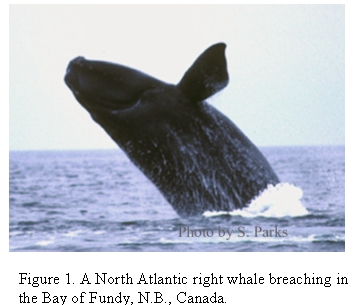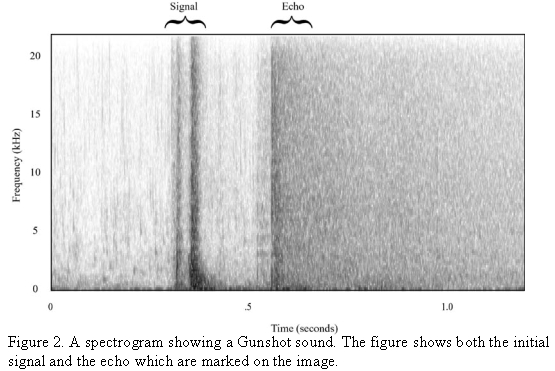Susan E. Parks - sep6@cornell.edu
Cornell Bioacoustics Research Program
159 Sapsucker Woods Rd.
Ithaca, NY 14850
Philip K. Hamilton & Scott D. Kraus
(New England Aquarium, Central Wharf, Boston, MA 02110)
Peter L. Tyack
(Woods Hole Oceanographic Institution, Woods Hole MA 02543)
Popular version of paper 4aAB12
Presented Thursday morning, May 27, 2004
147th ASA Meeting, New York, NY
| The North Atlantic right whale (Figure 1) is one of the most endangered species of whale in the world. Reduced to low numbers by whaling before the 19th century, this population of whales has failed to show signs of recovery, despite protection from whaling for over 65 years. Relatively little is known of how right whale use sounds in their daily life from potentially locating prey to contacting other whales. This paper describes a particularly striking sound produced by male right whales which may play a role in right whale mating. This sound is referred to as a 'gunshot' sound because it is similar to the sound of a rifle being fired |  |
The sound
The Gunshot is a brief, intense sound. In the
Bay of Fundy there is typically an initial sound, presumably traveling in a
straight path from the whale to the recording hydrophone, followed by a clear
echo (Figure 2). The time delay between the initial sound and the echo corresponds
to the expected time for the sound to travel twice the depth of the water suggesting
that the recorded echoes were reflections off the bottom. Acoustically, Gunshot
sounds are similar to sounds made from a whale slapping its flipper or tail
on the water, but are noticeably louder when recorded at the same distance from
the whale.

(Please click on spectrogram to hear an example "gunshot" sound)
Who, When, Where?
Lone males vs. Social Groups
The Gunshot sound has been recorded from male right whales in two very different
situations in the Bay of Fundy during the summer months. The sound was recorded
from lone males showing stereotyped repetitive surfacing behavior nine times
and from males engaged in rowdy social groups, referred to as 'surface active
groups' on 49 separate occasions. These surface active groups consist of anywhere
from 2-20+ whales and often involve multiple males competing to get close to
a single female who is producing calls that attract more whales. To date, there
have been no observations of females making the Gunshot sound.
How?
Production mechanism
The precise mechanism by which right whales make the Gunshot sound is unknown
but our observations indicate that the whales produce the sound internally.
Even though the sound is similar to slapping sounds made by whales slapping
the water, close observations of whales indicate that the sound is produced
without hitting the water's surface with a flipper or fluke. The entire body
of the whale producing the Gunshot sound has been seen to vibrate or jiggle
at the time of sound production. Whales produce the most intense Gunshot sounds
immediately after a head-lift. The information on the timing of the multiple
pulses of the sound, the intensity of the sound, and the production of the sound
at or near the water's surface may provide clues to the mechanism of sound production.
Gunshot sounds have only been reported in balaenid whales (including the bowhead
whale and other species of right whale). There may be unique anatomical features
of this group that could explain the production of this distinctive sound.
Why?
There are several potential functions for a such loud sound. The three primary
hypotheses include using the sound to stun prey, for echolocation to navigate
or locate food and other whales, or to communicate with other whales in social
situations. The prey of right whales in the Bay of Fundy consists primarily
of large concentrations of copepods, a tiny shrimp-like organism, and it is
unlikely that the right whales would need to use sound to stun or disorient
their relatively slow-moving prey. The production of Gunshot sounds by stationary
whales at the surface that are not traveling or feeding and in surface active
groups where the whales are in close body contact with other whales and the
female is already making sounds, make it unlikely that echolocation for finding
food or other whales is a primary function of the sound. The remaining hypothesis,
that the Gunshot sound functions for communication with other right whales,
seems the most plausible.
Only adult male right whales have been documented producing this sound in the
Bay of Fundy. This has led to the hypothesis that the sound serves a reproductive
function. Use of sound to mediate reproduction (both to repel competitors and
attract mates) is common in many species, particularly in the marine environment
where visibility is limited. The gunshot sound may represent a distinct sound
used by males in mating situations.
Given the current observations of Gunshot sound production in North Atlantic
right whales in two very different behavioral contexts it seems even more likely
that Gunshot sounds serve multiple functions. The use of the sound as an aggressive
threat signal appears to be strongly supported by the production of Gunshot
sounds in surface active groups with multiple males competing for access to
a single female. The role of the sound in reproductive advertisement is supported
by the displays of lone adult males on nine different occasions. The similarity
in the patterns of behavior and sound production between different individuals
suggest that this display is commonly used by mature males. The proposed function
of this display to attract females is a hypothesis, because it is currently
unknown what the outcome of these male displays might be, and no observations
of females joining displaying males have been made. Females may be able to assess
individual males within a surface active group by characteristics of the Gunshot
sounds that they produce. It seems likely that the potential function of this
sound encompasses both of the two proposed functions, with Gunshots functioning
as direct agonistic threats between males while allowing for assessment of individual
male quality by females.